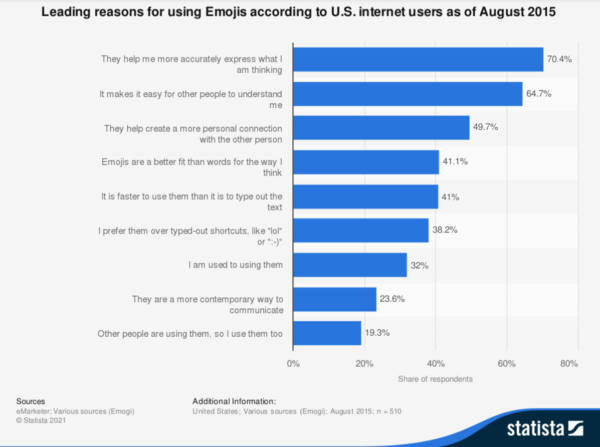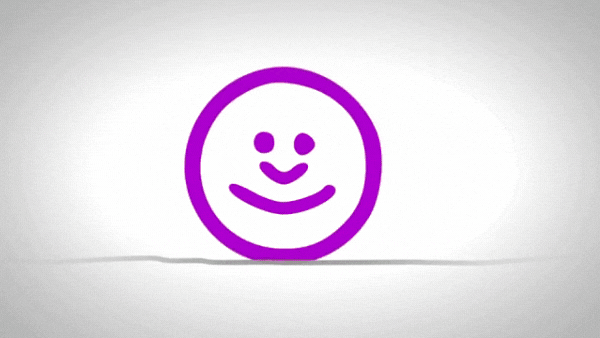Why emojis get our ✅ of approval
Emojis have the power to bring us together and to divide us. While writers and lovers of language are often the first to express their dislike for emojis, research shows that when used on social media, emoji use can increase engagement as much as 25 per cent.
We explore the benefits and drawbacks of the humble emoji.
Where did they come from? 🔭
Emoji’s predecessor was the emoticon, which used characters, numbers and punctuation marks to depict facial expressions and objects. They were first used in the 1980s after computer scientist Scott Fahlman proposed that 🙂 be used in text to communicate “attempted humour”. Fahlman suggested that emoticon could help us communicate emotion and be “used in place of language”.
As computer technology advanced and the internet became more commonplace in the 1990s, different cultures developed their own iterations, including Japanese manga and anime influenced emoticons like (^_^) and >.<. In fact, it was Japanese interface designer Shigetaka Kurita who first invented the emoji.
If you were born between 1981 and 1996, you probably spent the better part of your evenings chatting to mates on MSN Messenger. The Smiley Company was responsible for the technology that enabled us to add ‘smileys’ to text on computers, including on MSN messenger in 2001. A precursor to social media, emoticons and emojis were rife among MSN users… just ask ‘<(+_+)>JE$$IE<(+_+)>’ or ‘millie❤️z_aaron_4eva!!!1!!!’.

From 2004 onwards, Unicode began standardising emoji language. Mobile providers including Google and Apple collaborated with Unicode to make more emojis available across different platforms. And today, emojis are used by whopping 92 per cent of internet users.
An emoji worth a thousand words? 📖
In an interview with The Chicago Tribune, British linguist and author of The Emoji Code: The Linguistics Behind Smiley Faces and Scaredy Cats, Vyvyan Evans said that emojis are ‘intuitively accessible’.
Humans communicate in three different ways when face-to-face: language, paralanguage (how language is delivered through tone of voice) and kinesics (non-verbal communication like facial expressions and body language).
It can be difficult to convey the paralanguage and kinesics in written forms of digital interaction, while emojis provide an easy-to-use shorthand for both.

In 2015, researchers at eMarketer asked US internet users why they use emojis. The top four answers all reflect how emojis can enhance digital communications and help to build social connections.
Emojis are also time efficient. Humans process visual information 60,000 times faster than words, which means more information can be communicated more rapidly than with words alone.
Designers have long harnessed the power of using imagery within text to ‘say more’. One style called rebus, where images are interspersed with text, is making a comeback in consumer facing branding and identity. The American Institute for Graphic Arts (AIGA) are calling it Nouveau Rebus.
Emojis give our plain text and messages the same ingenuity as ‘Nouveau Rebus’. Australian radio host David Astle said that “our written speech is richer for pictographs, livelier, less ambiguous” and we tend to agree. Though, like words themselves, there’s a time and a place for an emoji 👀.
What’s the 🕒 and where’s the place❓
In the workplace
Although emojis are a valuable asset to digital communication, their use in professional settings can be met with a mixed reception.
A study undertaken by Adobe in 2019 found that of 1000 respondents 61 per cent used emojis at work and 78 per cent of respondents liked a person more if they sent emojis.
But much like face-to-face communication and language, emojis can be misinterpreted.
Many people apply different meanings to different emojis. According to research paper “Blissfully happy” or “ready to fight”: Varying Interpretations of Emoji a single emoji can be interpreted differently by individuals. In addition, the same emoji is rendered differently across platforms, which can make interpretation more difficult.
In a 2019 study, Adobe asked who participants sent emojis to at work. The majority said they use emojis only with people at their own level. This makes sense in terms of an individual’s reputation management and building camaraderie among colleagues, but what about emojis that make their way into conversations with clients, for instance? Using emojis in external conversations can be risky unless you have pre-existing rapport.
Shiran Weitzman, CEO and co-founder of a company specialising in eComms recording keeping and compliance, explores the ‘‘challenges of monitoring emoji speak’’ in internal communications. He explains that rogue emojis aren’t picked up as often by computer monitoring systems and, when they are, there can be difficulties determining what constitutes non-compliant use. Weitzman suggests that organisations would benefit from implementing emoji policies that outline which emojis can be used, how often and on what platforms are appropriate.

Social media
Emojis thrive on social media for a number of reasons, and many of them aren’t complex. Emojis engage audiences because they’re fun! In a sea of text, they stand out and have a pleasant, casual appearance.
If you’re not convinced, take a look at the stats:
- 51 per cent of participants in this survey said they are likely to engage with a brand’s posts if it includes emojis
- Quintly found that using emojis can increase engagement by up to 7 per cent
- Using an emoji in a tweet can increase engagement by 25 per cent
Harnessing the power of emojis not only increases social media engagement but also brand recall. Because we process images so much faster than words, the same images on repeat can improve brand recognition. Brandwatch suggest choosing a few key emojis that reflect your brand to use consistently as part of social media posts. Your audience will begin to associate those emojis with your brand and will think about you even when they aren’t engaging with your content.
However, if adopting emojis in your business communications is on the cards, it’s important to include emoji use in brand guidelines to avoid overuse or mix messages.
Emojis: 👍 or 👎?
❤️ them or 😡 them, there’s no denying that emojis have the power to enhance communications when used strategically. Their recognisability and ability to evoke emotions can give your brand an edge that sets you apart. Ultimately, the key is to know your audience.
There’s a reason big tech pushed for Unicode to standardise emojis. Emojis are a universal digital language. Although they can be open for interpretation, emojis can also bring diverse communities together and create shared understandings. But… we will let you make up your own 🧠.



